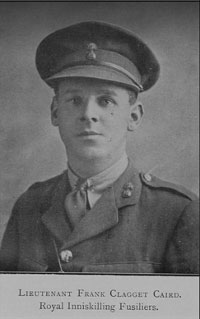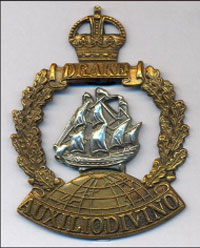
2nd Royal Inniskilling Fusiliers (3rd Battalion attached to 2nd Battalion): formerly 9/3421 Able Seaman, Royal Navy Volunteer Reserve.
Frank Clagget Caird was born at Rycroft Villas, Ossett on 29th March 1890, the second son of Welsh born Insurance Inspector Charles Randolf Caird and his wife Catherine (nee Woodcock) born in Wakefield.
The couple married at Holy Trinity Church Ossett on 22nd April 1885 and Frank was baptised there on 28th April 1890. Charles Randolph’s father was Charles Clagget Caird, a Professor of Music and Catherine’s father, Joshua Woodcock was described as a Gentleman. Catherine stated her residence as Ossett.
Frank had four siblings, an only brother Charles Donald (born1886 Headingley) and three sisters, Jessie Sybil (born 1888 Headingley), Lena Coral (born1897 Harrogate) and Gladys Marjorie (born 1899 Tynemouth).
By 1897 the family had left Ryecroft Villas, Ossett and by 1899 they were living at Cullercoats/Whitley in Northumberland, before moving on again by 1911 to live in the 9 roomed home, The Cedars, Forest Hall, Longbenton, Northumberland. The family comprised parents and four of their children, including Frank but excepting the eldest, Charles Donald, who was elsewhere. The household also had a Swiss Governess (Helene Julia Eugenie D’Ulon) and three servants, a housemaid, cook and gardener.
Unusually in 1911 there was a second Census entry for Frank Clagget Caird (by then a bank clerk) and his father, Charles Randolf when they were also recorded as boarders at the Cairn Hydro, Ripon Road, Harrogate. The Hydro (better known today as a Spa) is now a Hotel. Click here to see more of its fascinating history
What appeared to be an idyllic life for Frank Clagget Caird was shattered when war was declared on 4th August 1914. Two days later, on 6th August Frank, aged 24 years, enlisted in the Royal Navy Volunteer Reserve (RNVR). By 15th September Frank of 29, Thornton Avenue, Turnham Green, Chiswick, London was serving as 9/3421 Able Seaman. He was 5’ 6” tall with light brown hair and grey eyes. His father’s address, as next of kin, was Westfield Avenue Gosforth, Newcastle On Tyne.
The RNVR was a reserve of civilian volunteers founded in 1903 when the Admiralty were enabled by statute to raise the reserve to complement the Royal Naval Reserve (RNR) which consisted of professional civilian sailors whereas the RNVR was open to civilians with no prior sea experience. By the outbreak of WWI there were six RNVR divisions in major ports around the UK.
On 22nd December 1914 Frank moved to the Royal Naval Division (RND) and joined “Drake” Battalion, “B” Company. Although its men enlisted for service as sailors, they were deployed as infantrymen, who saw action in some of the most brutal fighting of the war and were considered elite troops. By June 1915 he was serving in the Dardanelles where he was hospitalised with sickness in June and August latterly with conjunctivitis. In spite of medical assistance at a Casualty Clearing Station he was invalided to England in mid-August 1915 aboard the H.S. Andania where he was treated for defective vision in Plymouth Hospital in early September 1915. Following two weeks leave he was assigned to 1st Reserve Battalion at Blandford and in December 1915 Frank was discharged from the RND.
 (Left) Royal Naval Division Drake Battalion Badge
(Left) Royal Naval Division Drake Battalion Badge
This was to be the end of his service in the Naval Forces but not the end of his service to his country for in mid January 1916 he was formally discharged by the RND and appointed to a Commission in the Army. He joined the Reserve 3rd Battalion and then attached to the 2nd Battalion Royal Inniskilling Fusiliers. The Irish Regiment raised 13 Battalions and was awarded 46 Battle Honours and 8 Victoria Crosses, losing 5,890 men during the course of the war. The 2nd Battalion was transferred to the 96th Brigade in the 32nd Division on 24th December 1915. In November 1915 the Division which was largely comprised of locally raised units often known as “Pals”, received a warning order to prepare to sail for France.
The London Gazette Supplement 20th January 1916 carried a notice that Frank Clagget Caird was to be appointed 2nd Lieutenant(probation) with effect from 21st January 1916. Frank’s Regiment, the 2nd Battalion Royal Inniskilling Fusiliers saw service from January 1916 and he would have seen action in the Albert, Bazentin and, finally, the Ancre Battles of The Somme which was to see the last day of The Battle of The Somme on 18th November 1916. Frank died of his wounds on 22nd November having almost certainly been treated, without success, at a Casualty Clearing Station.
The battle of the Ancre, 13-18 November 1916, involved an attack on the German front line as it crossed the Ancre River, a sector of the front that had been attacked on the first day of the battle without success.
The first British objective involved an advance of 800 yards and required the capture of at least three lines of trenches. The next target was the German second line, from Serre south to the Ancre. Finally it was hoped to capture Beaucourt, on the Ancre but this was delayed whilst the 51st Division captured Beaumont Hamel, and the 2nd Division captured parts of Redan Ridge. The attack was renewed on 14 November and Beaucourt fell at 10.30am.
This success encouraged a more ambitious offensive and one final attack was made, on 18th November. This began in snow and sleet and descended into chaos. The 97th Brigade, attacked at dawn to capture the German front line trenches. Machine gun and rifle held up the advance causing severe fighting and heavy losses. The battalion lost 14 officers and 351 other ranks killed or wounded. 2nd Lieutenant Frank Clagget Caird died of his wounds four days later on 22nd November 1916 and is remembered with Honour at Puchevillers British Cemetery (Plot III. Row B. Grave 9).
In June 1916, just before the opening of the Battles of the Somme, the 3rd and 44th Casualty Clearing Stations came to Puchevillers. Plots I to V, and almost the whole of Plot VI were made by those hospitals before the end of March 1917. Puchevillers British Cemetery contains 1,763 First World War burials located at Puchevillers village on the D11 about 19 km. north-east of Amiens.
Puchevillers British Cemetery (III.B.9)
2nd Lieutenant Frank Clagget Caird is also remembered at the Durham School Chapel dedicated within the Church. He was posthumously awarded the British, Victory and the 1914-15 Star Service Medals for services to the country in the Great War. He will also be remembered by his name at the Ossett War Memorial alongside his brothers and sisters in arms; The Ossett Fallen.
Research by the Ossett Fallen Team 2023. Biography by Alan Howe.
Sources
Commonwealth War Graves Commission
https://www.cwgc.org/find-records/find-war-dead/casualty-details/510931/f-c-caird/